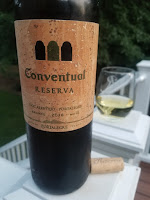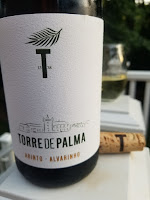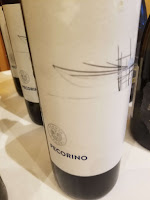 Ilok is a city and region located in the far eastern end of Croatia - adjacent to the Danube to its North and surrounded by Serbia except for a sliver of Croatian territory to the west. Grape growing started even before the Romans, by the Illyrians, and has survived millenniums of changing rulers. Viticulture continued throughout the Middle Ages and was reconstituted after the Ottoman occupation by the Odescalchi dukes, who in the "17th century built unique cellars underneath the Odescalchi castle, planted even more quality varieties, and started bottling wine".
Ilok is a city and region located in the far eastern end of Croatia - adjacent to the Danube to its North and surrounded by Serbia except for a sliver of Croatian territory to the west. Grape growing started even before the Romans, by the Illyrians, and has survived millenniums of changing rulers. Viticulture continued throughout the Middle Ages and was reconstituted after the Ottoman occupation by the Odescalchi dukes, who in the "17th century built unique cellars underneath the Odescalchi castle, planted even more quality varieties, and started bottling wine". Most of the vines are planted on the southern and southwestern slopes of Fruška Gora - a mountain centered in Serbia that was once an island in the ancient Pannonian sea. The western side of the mountain extends into eastern Croatia - specifically just south of the city. These Ilok vineyards are also known as the Srijem vineyards (from Vukovar-Srijem County) and receive a full day's exposure to the sun, with the hills positioned from 200 to 250 meters and containing porous flagstone soils. Grasevina, Rhine Riesling, and Traminac (Traminer) are the primary grapes planted.
Most of the vines are planted on the southern and southwestern slopes of Fruška Gora - a mountain centered in Serbia that was once an island in the ancient Pannonian sea. The western side of the mountain extends into eastern Croatia - specifically just south of the city. These Ilok vineyards are also known as the Srijem vineyards (from Vukovar-Srijem County) and receive a full day's exposure to the sun, with the hills positioned from 200 to 250 meters and containing porous flagstone soils. Grasevina, Rhine Riesling, and Traminac (Traminer) are the primary grapes planted. During our Spring trip to Slavonia, we participated in a whirlwind half-day tour of five wineries -- showcasing the history and modern approaches to Ilok winemaking. Will need to return for a more relaxed and in-depth visit.
Ilok Cellars (Iločki podrumi)
 In 1450, Nikola of Ilok (1) built a 100-meter-long wine cellar underneath his castle, which itself was built on the foundations of the former Roman fortress Cuccium. Wine production continued under the Ottoman occupation (1526 - 1688) and in 1697, the castle and significant properties around Ilok were granted to the Italian aristocratic Odescalchi family. They expanded the wine cellar and in 1710, the Odescalchis planted the first Gewürztraminer vines in the area on the unique single vineyard appellation – Principovac. (This is the site of the grand Odescalchi summer residence castle.) These Traminac grapes became the foundation for the famous 1947 Traminac vintage which was served at the coronation of Queen Elizabeth. During the Homeland War, the remaining bottles of this vintage, as well as the existing 8,000 library wines were saved from destruction by an innovative winery employee who build a false wall into the cellar. The wine that was not hidden was stolen and distilled into brandy by the Serbians. During our visit, we sampled several of the Iok Cellars wines and highly recommend the current vintages of Traminac - particularly the Premium Traminac 2020 (70 Kuna). The wine is dry with the accustomed string floral aroma, and a full-bodied, citrus, and stone fruit profile.
In 1450, Nikola of Ilok (1) built a 100-meter-long wine cellar underneath his castle, which itself was built on the foundations of the former Roman fortress Cuccium. Wine production continued under the Ottoman occupation (1526 - 1688) and in 1697, the castle and significant properties around Ilok were granted to the Italian aristocratic Odescalchi family. They expanded the wine cellar and in 1710, the Odescalchis planted the first Gewürztraminer vines in the area on the unique single vineyard appellation – Principovac. (This is the site of the grand Odescalchi summer residence castle.) These Traminac grapes became the foundation for the famous 1947 Traminac vintage which was served at the coronation of Queen Elizabeth. During the Homeland War, the remaining bottles of this vintage, as well as the existing 8,000 library wines were saved from destruction by an innovative winery employee who build a false wall into the cellar. The wine that was not hidden was stolen and distilled into brandy by the Serbians. During our visit, we sampled several of the Iok Cellars wines and highly recommend the current vintages of Traminac - particularly the Premium Traminac 2020 (70 Kuna). The wine is dry with the accustomed string floral aroma, and a full-bodied, citrus, and stone fruit profile. (1) Nicholas of Ilok was a Ban of Croatia, Slavonia, Dalmatia, and Macsó; Voivode of Transylvania; and titular King of Bosnia from 1471 until his death. A member of the Iločki noble family, he was one of the richest landowners in the Kingdom of Hungary and Croatia and one of its most influential magnates. He served under four kings of Hungary: Albert, Vladislaus I, Ladislaus V, and Matthias I.
Vina Papak This is the easternmost winery in both Ilok and in the whole of Croatia and is surrounded by Serbia in three directions. Mladen Papak is a first-generation winemaker and resurrected Iločki podrumi as its Director and Oenologist after the Homeland War. He and his brother first planted grapes at Radoško brdo in 2001 and then he converted his childhood home to a winery in 2014. His son Karl has retraced his Father's steps by graduating from the Faculty of Agriculture in Zagreb and will eventually succeed Mladen.
This is the easternmost winery in both Ilok and in the whole of Croatia and is surrounded by Serbia in three directions. Mladen Papak is a first-generation winemaker and resurrected Iločki podrumi as its Director and Oenologist after the Homeland War. He and his brother first planted grapes at Radoško brdo in 2001 and then he converted his childhood home to a winery in 2014. His son Karl has retraced his Father's steps by graduating from the Faculty of Agriculture in Zagreb and will eventually succeed Mladen.  Radoško brdo is located on the slopes of the Fruška Gora mountain and the vines face southern and southwestern positions -- providing a full day of sunshine. From 2001 to 2010 they planted Grasevina, Rhine Riesling, Traminac, Chardonnay, Cabernet Sauvignon, and Cabernet Franc.
Radoško brdo is located on the slopes of the Fruška Gora mountain and the vines face southern and southwestern positions -- providing a full day of sunshine. From 2001 to 2010 they planted Grasevina, Rhine Riesling, Traminac, Chardonnay, Cabernet Sauvignon, and Cabernet Franc.Radosh is a shortened name for the region and the Papak Radosh label is intended to ingrain consumer awareness of Light, Fresh, & Fruity. They also produce Vina Papak classic labels of Grasevina and Traminac. We only had time for white wines and loved all those presented, Grasevina, Chardonnay, Rhine Riesling, and Traminac. For me, the 2021 Vina Papak Grasevina and 2021 Radosh Chardonnay stood out. We were also treated to the 2016 Traminac Icewine, harvested on January 7th, 2017 at 7 degrees Fahrenheit. Simply delicious.
Vinarija Čobanković The family of Ivan Čobanković has been cultivating grapes for 50 years and making wine for the past 20 years. In 2022 they started with 21 hectares of vineyards but now they are “the biggest small winery in Croatia”. They cultivate or control approximately 200 hectares of vineyards and produce almost 2,000,000 liters of wine (the second largest after Ilok Cellars). Like many of the Srijem wineries, their vines along the slopes of Fruška Gora consist of Graševina, Pinot Gris, Chardonnay, Frankovka, Cabernet Sauvignon, and uniquely Grüner Silvaner (a descendent of Traminer), Unfortunately during our rushed and late-night visit we were only able to sample three of these: Graševina, Pinot Gris, and Grüner Silvaner. The 2022 Pinot Sivi was very unique, aged in barrique and undergoing malolactic fermentation it is heavier and creamier than others in its class. The 2021 Silvanac Zeleni (Grüner Silvaner) is very fresh, with lots of citrus and acidity for a palate cleanser.
The family of Ivan Čobanković has been cultivating grapes for 50 years and making wine for the past 20 years. In 2022 they started with 21 hectares of vineyards but now they are “the biggest small winery in Croatia”. They cultivate or control approximately 200 hectares of vineyards and produce almost 2,000,000 liters of wine (the second largest after Ilok Cellars). Like many of the Srijem wineries, their vines along the slopes of Fruška Gora consist of Graševina, Pinot Gris, Chardonnay, Frankovka, Cabernet Sauvignon, and uniquely Grüner Silvaner (a descendent of Traminer), Unfortunately during our rushed and late-night visit we were only able to sample three of these: Graševina, Pinot Gris, and Grüner Silvaner. The 2022 Pinot Sivi was very unique, aged in barrique and undergoing malolactic fermentation it is heavier and creamier than others in its class. The 2021 Silvanac Zeleni (Grüner Silvaner) is very fresh, with lots of citrus and acidity for a palate cleanser. Vinarija Buhač
 This is a small family winery that has owned and cultivated vineyards since 1982, opened the winery in 1998, and today cultivates 20 hectares of vineyards -- 16 hectares of white varieties and 4 hectares of red varieties. These grapes consist of Graševina, Rhine Riesling, Traminac, Pinot Blanc, Chardonnay, Sauvignon Blanc, Cabernet Sauvignon, and Merlot. We were invited into their quaint tasting area for a late-night serving of wine, cheese, and kobasica. We started with the 2021 Graševina which showed green apple, white flowers, citrus, and that pleasant bitterness that we've come to expect from this wine. The Buhač Sauvignon 2021 provided an opportunity to contrast the international variety in different regions and this provides more melons over lemongrass with distinct herbaceous qualities. The Buhač Rosé 2021 is on the fruitier side with plenty of acidity to pair alongside the strawberry and raspberry flavors. The most interesting wine we sampled was the single vineyard Buhač Merlot Liska 2019. The wine is very drinkable now, with black fruits mingling with subtle vanilla and spices.
This is a small family winery that has owned and cultivated vineyards since 1982, opened the winery in 1998, and today cultivates 20 hectares of vineyards -- 16 hectares of white varieties and 4 hectares of red varieties. These grapes consist of Graševina, Rhine Riesling, Traminac, Pinot Blanc, Chardonnay, Sauvignon Blanc, Cabernet Sauvignon, and Merlot. We were invited into their quaint tasting area for a late-night serving of wine, cheese, and kobasica. We started with the 2021 Graševina which showed green apple, white flowers, citrus, and that pleasant bitterness that we've come to expect from this wine. The Buhač Sauvignon 2021 provided an opportunity to contrast the international variety in different regions and this provides more melons over lemongrass with distinct herbaceous qualities. The Buhač Rosé 2021 is on the fruitier side with plenty of acidity to pair alongside the strawberry and raspberry flavors. The most interesting wine we sampled was the single vineyard Buhač Merlot Liska 2019. The wine is very drinkable now, with black fruits mingling with subtle vanilla and spices.  This winery is built upon the remains of the region's first wine association, First the Sriem Vineyard Joint Stock Company, formed on January 30, 1872. The association only lasted 20-25 years -- deteriorating due to the phylloxera epidemic. But its legacy is an old 834 squared meter wine cellar built around 1885 which the owners of TRS plan to refurbish. These owners are the Bosnjak and Feletar families who merged their respective family farms and winemaking equipment into the TRS Agricultural Cooperative. The TRS Winery opened a year later where they had a production capacity of 80,000 liters while cultivating 29 hectares of vines. Seeking to expand further, the cooperative added Ilija Tokic as an investor and strategic partner and moved to the remains of the First the Sriem Vineyard Joint Stock Company.
This winery is built upon the remains of the region's first wine association, First the Sriem Vineyard Joint Stock Company, formed on January 30, 1872. The association only lasted 20-25 years -- deteriorating due to the phylloxera epidemic. But its legacy is an old 834 squared meter wine cellar built around 1885 which the owners of TRS plan to refurbish. These owners are the Bosnjak and Feletar families who merged their respective family farms and winemaking equipment into the TRS Agricultural Cooperative. The TRS Winery opened a year later where they had a production capacity of 80,000 liters while cultivating 29 hectares of vines. Seeking to expand further, the cooperative added Ilija Tokic as an investor and strategic partner and moved to the remains of the First the Sriem Vineyard Joint Stock Company. TRS vineyards on the slopes of Fruška Gora – Vinogorja Srijem are at an altitude of 200 to 260 meters, which includes the areas: Dekan, Veliko Brdo, Principal, Vukovo, Radjevac, and Radoš. And like Vina Papak the vines are Graševina, Chardonnay, Rhine Riesling, Traminac, Cabernet Sauvignon, and Cabernet Franc -- with additional plots of Frankovka (Blaufrankish).
TRS vineyards on the slopes of Fruška Gora – Vinogorja Srijem are at an altitude of 200 to 260 meters, which includes the areas: Dekan, Veliko Brdo, Principal, Vukovo, Radjevac, and Radoš. And like Vina Papak the vines are Graševina, Chardonnay, Rhine Riesling, Traminac, Cabernet Sauvignon, and Cabernet Franc -- with additional plots of Frankovka (Blaufrankish). During our visit, we saw firsthand how the winery has an extremely diverse portfolio, both in terms of the grape varieties vinified but also in the different styles for the same variety. We sampled lots of wine, from Graševina in the tank to aged Graševina in the bottle. Their 2015 Graševina highlights the age-ability of that variety where some of the acidity is displaced for a fuller body. The fresher side of most of their current Graševina shows a range of fruit flavors from lemon to apple with a slightly bitter finish. Their Rhine Riesling and Traminac are solid with a Late Harvest 2017 Traminac, excellent. TRS produces more red wines than its neighbors and we sampled the very respectable 2016 Cabernet Sauvignon and 2017 Cabernet Franc. But the highlight was the delicious and completely unique 2018 3 C's. This is a blend of Cabernet Sauvignon, Cabernet Franc, and Carmenere, with the latter perhaps the only time vinified in Croatia. The winery purchased and planted what they thought was Frankovka. Five years later they determined that the vines were, in fact, Carmenere, and the 3 C's was born. This is a luscious wine, with black fruit, some spices, chocolate, and earthiness.
During our visit, we saw firsthand how the winery has an extremely diverse portfolio, both in terms of the grape varieties vinified but also in the different styles for the same variety. We sampled lots of wine, from Graševina in the tank to aged Graševina in the bottle. Their 2015 Graševina highlights the age-ability of that variety where some of the acidity is displaced for a fuller body. The fresher side of most of their current Graševina shows a range of fruit flavors from lemon to apple with a slightly bitter finish. Their Rhine Riesling and Traminac are solid with a Late Harvest 2017 Traminac, excellent. TRS produces more red wines than its neighbors and we sampled the very respectable 2016 Cabernet Sauvignon and 2017 Cabernet Franc. But the highlight was the delicious and completely unique 2018 3 C's. This is a blend of Cabernet Sauvignon, Cabernet Franc, and Carmenere, with the latter perhaps the only time vinified in Croatia. The winery purchased and planted what they thought was Frankovka. Five years later they determined that the vines were, in fact, Carmenere, and the 3 C's was born. This is a luscious wine, with black fruit, some spices, chocolate, and earthiness.







































